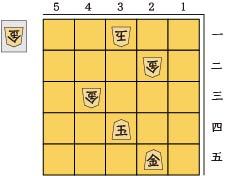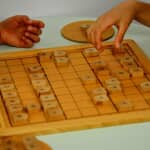Shogi 1 November 2016
Shogi Rules – How to Play Shogi – : Step 1-11 Let’s Play a 5×5 Shogi Game (Mini Shogi)
Explore art of Shogi. A professional Shogi player invites you to the world of Shogi along with traditional Japanese culture.
*Please note that the Kanji numbers in pictures are spelled in English in the text.
The following Shogi boards have a face with files (vertical rows) numbered 1 through 9 from right to left, and ranks (horizontal rows) designated with Kanji characters, “一” (One) to “九” (Nine), from top to bottom. On the other hand, in the text, each Kanji character is replaced with an alphabet, from “a” to “i” : “一” with “a”, “二” with “b”, … and “九” with ”i”.
Finally, this is the last lesson of Step 1. Let’s place Gyoku (King) on each side and play.
The previous step
Let’s Play a 5×5 Shogi Game
The game starts with saying “Onegai shimasu (I’d like to rely on you to play this game with me.)” Also, when you lose unfortunately, you need to declare your loss by saying “Makemashita (I’ve lost).”
The game of Shogi ends with the loser’s declaration of his/her own loss called “Toryo” in Japanese. So, this is not happy but a very important greeting. Then, the game is terminated with both players saying “Arigato gozaimashita (Thank you very much).”
If you practice these greetings now, I think you will be able to naturally greet when you play the standard 9×9 Shogi.

Let’s place two pieces of Kin (Gold) and Gyoku (King) as the above picture to start. We use a boar which has 5×5 squares instead of that with 9×9 squares.
It could be very difficult to capture Gyoku (King) with the limited numbers of pieces. If it is too hard to capture Gyoku (King), let’s switch Sente (person with the first move) and Gote (person with the second move), and continue to practice.
The goals of this practice are as follows.
- To be able to take a turn to move a piece
- To be able to properly move Gyoku (King) and Kin (Gold)
- To be able to understand how to capture Gyoku (King)
Also, this 5×5 Shogi is a good practice to read three moves ahead. The three moves go as below.
- You move your own piece.
- The opponent captures your piece.
- You captured back the opponent’s piece.
When you come to visualize these three moves in you mind, you can read three moves ahead.
Look at the following picture.

You move the left Kin (Gold) one step forward. (▲G-4c)
* “-” means a move without a drop or capture occurring.

The opponent captures your Kin (Gold) . (△Gx4c)
* “x” means a move that captures a piece.

You captured the opponent’s Kin (Gold) with Gyoku (King). (▲Kx4c)
* “x” means a move that captures a piece.

As a matter of fact, you switched yourKin (Gold) with the opponent’s Kin (Gold). So, this is no loss and no gain. However, the captured opponent’s Kin (Gold) is now yours as the piece in hand. Thus, you can freely drop the Kin (Gold) piece on the board.
You switch the pieces, and change the piece on board to the piece in hand. Then, you can practice how to freely drop pieces on the board. Your opponent can do the same, though.
Once you feel confident about the above moves, let’s go to the next step.
It will be even more fun since many other pieces will join hereafter.
Comments from the girls’ mother
Step 1 is over, finally!
My girls were very serious about 5×5 Shogi games. They used only three pieces but the game was pretty profound.
Ms. Akiko says that switching pieces is a good practice to read three moves ahead.
Shogi players are required to be able to “read ahead.” That’s why Shogi is useful to gain a good thinking skill.
I hardly see my girls thinking so hard. I am thrilled to see that they gain a good thinking skill more and more in the future Shogi lessons.
The next step





